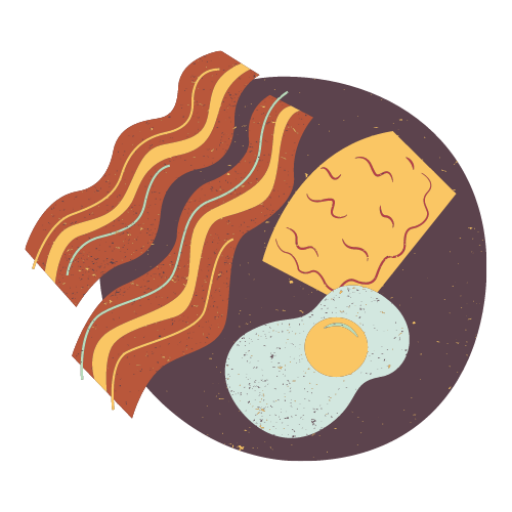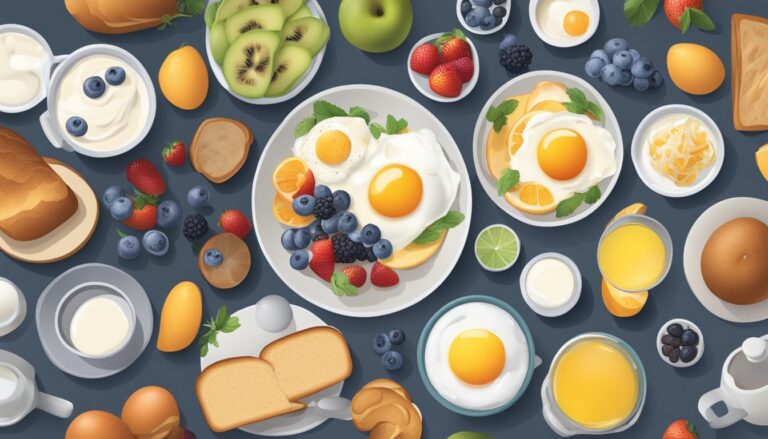Gluten-free breakfast options have become increasingly popular as more people adopt gluten-free diets for health reasons or personal preferences. Whether you have celiac disease, gluten sensitivity, or simply want to reduce your gluten intake, there are numerous delicious and nutritious breakfast choices available.
Many breakfast foods are naturally gluten-free, requiring no special ingredients or complicated substitutions. From protein-packed egg dishes to hearty oatmeal bowls and refreshing smoothies, these recipes offer a variety of flavors and textures to start your day off right. By focusing on whole foods like fruits, vegetables, nuts, and gluten-free grains, you can create satisfying meals that are both tasty and beneficial for your health.
1) Avocado Toast
Avocado toast is a popular gluten-free breakfast option that combines simplicity and nutrition. This dish typically features mashed avocado spread on toasted gluten-free bread.
To prepare, start by selecting ripe avocados and gluten-free bread of choice. Toast the bread until golden and crispy. While the bread toasts, mash the avocado with a fork and season with salt, pepper, and lemon juice to taste.
Spread the seasoned avocado mixture generously on the toasted bread. For added flavor and texture, top with ingredients like sliced tomatoes, crumbled feta cheese, or a sprinkle of red pepper flakes.
Those seeking extra protein can add a fried or poached egg on top. For a dairy-free version, nutritional yeast provides a cheesy flavor without the dairy.
Avocado toast offers a balanced combination of healthy fats, fiber, and complex carbohydrates. It’s easily customizable to suit individual preferences and dietary needs, making it a versatile gluten-free breakfast choice.
2) Chia Seed Pudding
Chia seed pudding is a versatile and nutritious gluten-free breakfast option. This simple dish combines chia seeds with milk and sweetener, creating a creamy, pudding-like consistency.
To prepare chia seed pudding, mix chia seeds with your choice of milk, such as coconut or almond milk. Add a natural sweetener like honey or maple syrup, along with vanilla extract for flavor.
Let the mixture sit in the refrigerator for at least 4 hours or overnight. The chia seeds absorb the liquid, expanding to form a thick, gel-like texture.
For added variety, incorporate fruits, nuts, or spices. Mashed banana, cinnamon, or fresh berries can enhance the flavor profile. Some recipes suggest warming the pudding for a comforting twist.
Chia seed pudding offers a good source of fiber, protein, and omega-3 fatty acids. It’s easily customizable to suit different tastes and dietary needs, making it a popular choice for gluten-free breakfasts.
3) Banana Oat Pancakes
Banana oat pancakes offer a delicious gluten-free breakfast option. These pancakes combine ripe bananas with oats to create a naturally sweet and hearty meal.
The basic recipe typically includes mashed bananas, oat flour or rolled oats, eggs, and a few simple ingredients. Some variations incorporate cinnamon or vanilla for extra flavor.
Preparation is straightforward. The ingredients are blended until smooth, then cooked on a griddle or skillet. The batter can be prepared in advance for quick morning meals.
These pancakes are not only gluten-free but also pack a nutritional punch. Bananas provide potassium and fiber, while oats contribute additional fiber and protein.
Toppings can range from classic maple syrup to fresh berries, chopped nuts, or a dollop of Greek yogurt. For added indulgence, some recipes suggest mixing in chocolate chips or walnuts.
Banana oat pancakes freeze well, making them an excellent option for meal prep. They can be reheated in a toaster or microwave for a quick and satisfying breakfast any day of the week.
4) Sweet Potato Hash
Sweet potato hash is a delicious and naturally gluten-free breakfast option. This versatile dish combines diced sweet potatoes with various vegetables and proteins for a hearty morning meal.
To prepare sweet potato hash, start by cooking diced sweet potatoes until they’re crispy on the outside and tender on the inside. This can be done in a skillet with a bit of oil over medium heat.
Add chopped onions, bell peppers, and garlic to the skillet for extra flavor and nutrition. Some recipes include bacon or sausage for added protein, while others keep it vegetarian-friendly.
For a complete breakfast, top the hash with eggs cooked to your preference. Fried or poached eggs work particularly well, as the runny yolk mixes with the hash for a creamy texture.
Season the dish with salt, pepper, and spices like paprika or cumin to enhance the flavors. Fresh herbs such as cilantro or parsley can be sprinkled on top for a bright finish.
Sweet potato hash is not only tasty but also nutritious. Sweet potatoes provide fiber, vitamins, and minerals, making this a satisfying and wholesome way to start the day.
5) Zucchini Fritters
Zucchini fritters offer a delightful gluten-free breakfast option. These savory pancakes combine shredded zucchini with gluten-free flour, eggs, and seasonings.
To prepare, grate zucchini and squeeze out excess moisture. Mix the zucchini with gluten-free flour, beaten eggs, and herbs like chives. Add salt, pepper, and garlic powder for extra flavor.
Heat oil in a skillet over medium heat. Drop spoonfuls of the mixture into the pan, flattening them slightly. Cook until golden brown on both sides, about 2-3 minutes per side.
For added protein, some recipes incorporate cheese into the batter. Parmesan or feta work well, complementing the mild zucchini flavor.
Serve the fritters hot, garnished with a dollop of sour cream or Greek yogurt. They pair nicely with a side of mixed greens or sliced tomatoes for a complete breakfast.
These fritters can be made ahead and reheated, making them convenient for busy mornings. They also freeze well, providing a quick gluten-free option when time is short.
6) Quinoa Breakfast Bowl
Quinoa breakfast bowls offer a nutritious and naturally gluten-free start to the day. This versatile grain-like seed provides a complete protein source, making it an excellent choice for those avoiding gluten.
Quinoa can be prepared with various liquids, such as almond milk or water, and flavored with cinnamon, vanilla, or other spices. Once cooked, it forms a hearty base for both sweet and savory toppings.
For a sweet option, quinoa can be paired with fresh fruits like strawberries, bananas, or blueberries. Adding nuts, seeds, and a drizzle of honey creates a satisfying and energizing meal.
Savory quinoa bowls incorporate vegetables, eggs, and spices for a more robust flavor profile. Roasted sweet potatoes, chickpeas, and avocado make excellent additions, while a sprinkle of salt and pepper enhances the taste.
These bowls are highly customizable, allowing for a wide range of ingredients to suit individual preferences and dietary needs. Quinoa breakfast bowls can be prepared in advance, making them a convenient option for busy mornings.
7) Egg and Cheese Muffins

Egg and cheese muffins offer a protein-packed, gluten-free breakfast option that’s easy to prepare and customize. These savory muffins combine beaten eggs with shredded cheese and various add-ins for a flavorful morning meal.
To make egg and cheese muffins, start by whisking eggs in a large bowl. Add salt, pepper, and any desired spices for extra flavor. Shredded cheddar cheese is a popular choice, but other varieties like mozzarella or Parmesan work well too.
For added nutrition and taste, incorporate vegetables such as spinach, diced tomatoes, or bell peppers. Cooked meats like bacon or sausage can also be included for those seeking a heartier option.
Grease a muffin tin and distribute the egg mixture evenly among the cups. Bake at 350°F (175°C) for about 20 minutes or until the eggs are set and lightly golden on top.
These muffins can be made ahead of time and stored in the refrigerator for quick, grab-and-go breakfasts throughout the week. They’re versatile, allowing for endless combinations of ingredients to suit individual tastes and dietary needs.
8) Greek Yogurt Parfait
Greek yogurt parfait is a delicious and naturally gluten-free breakfast option. This layered treat combines creamy Greek yogurt with fresh fruits and crunchy toppings for a satisfying morning meal.
To create a Greek yogurt parfait, start with a base of thick, protein-rich Greek yogurt. Layer it with a variety of mixed berries such as strawberries, blueberries, and raspberries for added flavor and nutrients.
For sweetness, drizzle honey over the layers. This natural sweetener complements the tartness of the yogurt and berries perfectly. To add texture and boost nutritional value, sprinkle gluten-free granola between the layers.
For extra nutrition, consider adding a teaspoon of chia seeds to your parfait. These tiny seeds are packed with omega-3 fatty acids and fiber. The parfait can be assembled in a glass jar or container for easy transport and storage.
Greek yogurt parfaits can be prepared in advance and stored in the refrigerator for up to three days. This makes them an excellent option for busy mornings or on-the-go breakfasts.
9) Baked Eggs with Spinach

Baked eggs with spinach offer a naturally gluten-free breakfast option that combines protein and vegetables. This dish can be prepared in individual ramekins or a larger skillet for family-style serving.
To make baked eggs with spinach, one starts by sautéing spinach with olive oil and seasonings. Onions or shallots can be added for extra flavor. Once the spinach has wilted, it forms a bed for the eggs.
Fresh eggs are then cracked directly onto the spinach. The dish is seasoned with salt and pepper before being placed in a preheated oven. Baking time varies depending on desired egg consistency, typically around 15-17 minutes.
For those who tolerate dairy, grated cheese can be sprinkled over the spinach before adding the eggs. This adds richness and flavor to the dish.
Baked eggs with spinach can be customized with additional ingredients like mushrooms or prosciutto. These additions provide variety and can turn this simple breakfast into a more substantial meal.
This versatile recipe works well for both breakfast and dinner. It’s high in protein and low in calories, making it a nutritious choice for those following various dietary plans.
10) Almond Flour Waffles
Almond flour waffles offer a delicious gluten-free alternative to traditional wheat-based waffles. These crispy, golden treats are low in carbohydrates and rich in protein, making them a satisfying breakfast option.
To prepare almond flour waffles, combine almond flour, tapioca starch, and baking powder in a bowl. In a separate bowl, whisk together eggs, coconut cream, oil, and vanilla extract. Mix the wet and dry ingredients to create a thick batter.
Preheat the waffle iron according to the manufacturer’s instructions. Lightly coat the iron with cooking spray before adding the batter. Cook until the waffles are golden brown and crispy on the outside.
For added flavor, consider incorporating lemon zest or cinnamon into the batter. Serve the waffles warm with fresh berries, a drizzle of maple syrup, or a dollop of whipped cream.
These waffles can be made ahead and frozen for quick weekday breakfasts. Simply reheat them in a toaster or oven for a crispy texture. Almond flour waffles provide a nutritious and tasty start to the day for those following gluten-free or low-carb diets.
11) Smoothie Bowl
Smoothie bowls offer a naturally gluten-free breakfast option that’s both nutritious and customizable. These thick, creamy concoctions are served in a bowl and topped with various ingredients for added texture and flavor.
The base of a smoothie bowl typically consists of blended frozen fruits, vegetables, and a liquid like almond milk or coconut water. Popular fruit choices include berries, bananas, and tropical fruits like mango or pineapple.
To boost protein content, Greek yogurt or plant-based protein powders can be incorporated into the smoothie mix. For added nutrients, ingredients like spinach, kale, or carrots can be blended in without significantly altering the taste.
Toppings are what set smoothie bowls apart from regular smoothies. Common gluten-free options include sliced fresh fruits, nuts, seeds, coconut flakes, and gluten-free granola. These toppings add crunch and extra nutritional value to the meal.
Smoothie bowls can be tailored to individual tastes and dietary needs. They’re easily adaptable for those avoiding dairy or following vegan diets. With endless combination possibilities, smoothie bowls provide a refreshing and satisfying gluten-free breakfast option.
12) Frittata with Vegetables
Frittatas are a versatile and naturally gluten-free breakfast option. They’re essentially an open-faced omelet packed with vegetables and cooked in a skillet.
To make a vegetable frittata, start by sautéing your chosen vegetables in a skillet with some oil. Popular choices include bell peppers, mushrooms, spinach, and onions.
Whisk eggs in a bowl and season with salt and pepper. For added flavor, you can include herbs like parsley or basil. Pour the egg mixture over the cooked vegetables in the skillet.
Allow the frittata to cook on the stovetop until the edges begin to set. Then, transfer the skillet to a preheated oven to finish cooking. This ensures the top is fully set and lightly golden.
For those who tolerate dairy, adding cheese to the frittata can enhance its flavor and texture. However, it’s entirely optional and can be omitted for a dairy-free version.
Serve the frittata hot, directly from the skillet. It can be cut into wedges and paired with a side salad for a complete meal. Leftover frittata can be refrigerated and reheated for quick breakfasts throughout the week.
13) Egg and Avocado Breakfast Sandwich

Egg and avocado breakfast sandwiches offer a delicious gluten-free option for morning meals. This recipe combines creamy avocado with protein-rich eggs on gluten-free bread for a satisfying start to the day.
To prepare, toast two slices of gluten-free bread. While the bread toasts, mash half an avocado with a squeeze of lime juice and a pinch of salt.
Fry or poach an egg to your desired doneness. Spread the mashed avocado on one slice of toasted bread, then top with the cooked egg.
For added flavor and nutrition, consider including extras like sliced tomatoes, spinach leaves, or dairy-free cheese. These additions can enhance both taste and nutritional value.
Place the second slice of bread on top to complete the sandwich. For a more open-faced version, leave off the top slice and add a sprinkle of seeds or microgreens.
This gluten-free breakfast sandwich is not only tasty but also provides a good balance of healthy fats, protein, and complex carbohydrates to fuel your morning.
14) Coconut Flour Pancakes
Coconut flour pancakes offer a delicious gluten-free alternative to traditional wheat-based pancakes. These light and fluffy pancakes are made using coconut flour as the primary dry ingredient.
The batter typically includes eggs, almond milk or another dairy-free milk, melted coconut oil, and a touch of maple syrup for sweetness. Baking powder and baking soda help create a fluffy texture.
Mixing the wet and dry ingredients separately before combining them ensures a smooth batter. Some recipes incorporate additional ingredients like vanilla extract or chopped nuts for extra flavor.
Cooking coconut flour pancakes requires a bit more patience than regular pancakes. They are best cooked over medium-low heat for 3-4 minutes per side until golden brown.
These pancakes can be customized with various toppings. Fresh berries, sliced bananas, or a drizzle of pure maple syrup complement the subtle coconut flavor nicely.
Coconut flour pancakes are not only gluten-free but also high in fiber and protein. They make a satisfying and nutritious breakfast option for those following a gluten-free diet.
15) Shakshuka

Shakshuka is a vibrant and flavorful breakfast dish that naturally fits into a gluten-free diet. This North African and Middle Eastern staple features eggs poached in a rich tomato sauce, seasoned with aromatic spices.
To prepare shakshuka, start by sautéing onions and bell peppers in olive oil until tender. Add minced garlic, cumin, paprika, and chili powder for depth of flavor. Pour in crushed or diced tomatoes and let the sauce simmer until it thickens slightly.
Create small wells in the sauce and crack eggs directly into them. Allow the eggs to cook until the whites are set but the yolks remain runny. The entire dish can be prepared in one pan, making it both convenient and easy to clean up.
Shakshuka is typically served straight from the skillet, often accompanied by gluten-free bread or flatbread for dipping. This protein-rich meal is not only satisfying but also adaptable. Some variations include adding chickpeas for extra texture and nutrition.
Benefits of Gluten-Free Breakfasts

Gluten-free breakfasts offer numerous advantages for health and wellbeing. They provide essential nutrients while supporting digestive comfort for those with gluten sensitivities or celiac disease.
Nutritional Advantages
Gluten-free breakfast options often incorporate nutrient-dense whole foods. Fresh fruits and vegetables supply vitamins, minerals, and antioxidants. Eggs deliver high-quality protein and essential amino acids.
Nuts and seeds provide healthy fats, fiber, and micronutrients. Gluten-free grains like quinoa and buckwheat offer complex carbohydrates and additional protein.
Many gluten-free breakfasts emphasize whole, unprocessed ingredients. This focus can lead to increased intake of beneficial nutrients and reduced consumption of added sugars and artificial additives.
Digestive Health
For individuals with celiac disease or gluten sensitivity, gluten-free breakfasts are essential for digestive wellbeing. Eliminating gluten helps prevent intestinal damage and reduces symptoms like bloating and abdominal pain.
Gluten-free options often include fiber-rich foods that support healthy digestion. Fruits, vegetables, and gluten-free whole grains promote regular bowel movements and feed beneficial gut bacteria.
Some people without diagnosed gluten issues report improved digestion and increased energy when adopting gluten-free breakfasts. However, it’s important to maintain a balanced diet and consult a healthcare professional before making significant dietary changes.
Common Ingredients in Gluten-Free Recipes
Gluten-free breakfast recipes rely on specific ingredients to create delicious and nutritious meals. These components provide texture, flavor, and essential nutrients without containing gluten.
Naturally Gluten-Free Grains
Rice, quinoa, and oats are popular gluten-free grains used in breakfast recipes. Rice can be prepared as a savory porridge or used to make crispy waffles. Quinoa adds protein and fiber to morning meals, working well in breakfast bowls or as a base for egg dishes.
Oats, while naturally gluten-free, require careful selection to avoid cross-contamination. Certified gluten-free oats are ideal for making oatmeal, granola, or as an ingredient in baked goods.
Buckwheat, despite its name, is not related to wheat and is gluten-free. It can be used to make pancakes or as a hot cereal.
Fresh Fruits and Vegetables
Fresh produce forms the foundation of many gluten-free breakfast options. Fruits like berries, bananas, and apples add natural sweetness and essential vitamins to morning meals. They can be eaten raw, added to smoothies, or used as toppings for gluten-free cereals and yogurt parfaits.
Vegetables play a crucial role in savory gluten-free breakfasts. Potatoes, sweet potatoes, and bell peppers are excellent choices for hash browns or breakfast skillets. Spinach, tomatoes, and mushrooms work well in omelets or frittatas.
Avocados provide healthy fats and can be mashed on gluten-free toast or added to smoothie bowls for a creamy texture.




